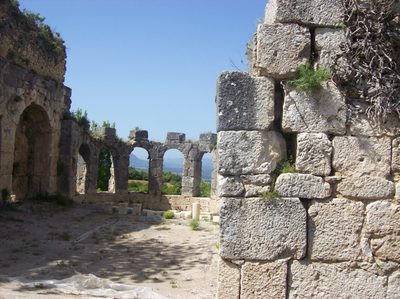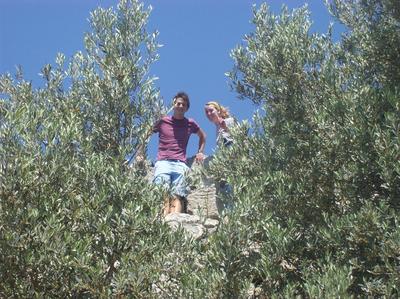Tlos
Our first stop after our hour and a half ride into the mountains was to the site the Hittites called Tlawa and the Romans Tlos. It is being excavated by the Med University in Antalya, and has been excavated since 1838. It is on the eastern side of the Xanthos Valley and had connections with that city. It was founded around the 12th Century BCE and then conquered by the Persians in the 5th Century BCE. It had a population of around 6,000 to 6,500 and was the religious center of the 6 Lykian cities.
The first part of Tlos we visited was the Stadium, Acropolis and the surrounding necropolis. The Stadium had a pool sepina and fountains instead of a line or monuments down the middle. The water filling these came from a spring on White Mountain, which is part of the Taurus Mountains. The Necropolis showcased the 3 burial styles – pigeon-hole, house, and temple. From the Acropolis we could see the entire Xanthos Valley and the Ottoman Castle built in the 19th Century by Canle (Bloody) Ali, who killed over 5,000 people during his reign.
We learned here that the city claimed to be the birthplace of Bellerophontos, a hero who killed the Chimera (lion, serpent, and goat) and then rode Pegasus to try to reach the gods and was killed for his insolence. A new tomb with art depicting this event is said to be his tomb.
Our hike began here, and we walked over to the Roman Baths and Sauna. The Baths had 7 doors and the Sauna 3, and both were recovered after 2 years of heavy growth removal. The Theatre had been decimated by an earthquake. It was built by the Romans, indicated by the flatness and the stage. It could seat 7,000 and due to little looting, the seats were very well preserved and showed their decorations beautifully. We hiked 9 km or almost 6 miles to a mosque in a little village before being bused to Xanthos.
Xanthos
When we got to Xanthos we immediately went through the necropolis to the Theatre. Michelle told us that Xanthos was the capital of Lykia and was founded by Sarpedon and Lycsus. It was the home of a proud, independent, rough people that were conquered in name only. The Persians (according to Herodotus) conquered all of Asia Minor in 540 BCE. The warriors of Xanthos fought one battle, lost, and then gathered all possessions and women and children to burn everything. They battled and lost again, so they committed a mass suicide. 80 families not present then formed the Dynas family and became governors of the area. In 334 BCE Alexander the Great conquered the area. Since the Persians were heavy-handed, the people of Xanthos liked him. In 40 BCE Brutus, one of the killers of Julius Caesar, conquered Xanthos, and the people committed mass suicide again. Augustus freed them. During Byzantine rule a bishop was located here, and it was conquered later on by nomadic Turks. It was “rediscovered” in 1838 by Charles Fellow who took the biggest monuments to the British Museum and left terrible records. The French have excavated here since 1951.
All of the Lykian Tombs in the necropolis nearby are copies of the originals. Ancestor worship had strong identity ties with the people of Xanthos, and this is indicated by the fact that the necropolis is inside the city. The three types of tombs depended on social status. Pigeon-hole tombs were built into the sides of mountains and were for the poor people; house-cut tombs were also built into cliffs and had wood house facades on the outside of it; temple-cut had pillars. All were built during the Dynas rule. The Cariga tomb was the smaller house-cut tomb and the Harpies (or sirens) tomb was the larger house-cut tomb. The Obelisk or Inscribed Pillar was built by a brother and war reliefs and the Lykian language on it, but it was also taken. The largest tomb was at the entrance and called the Nere tomb for Erbina Dynas. It was Greek with Lykian pillars and had reliefs of hunting, dining, and nymphs. The region overall had pressure from the Persians, Greeks, Romans, and Lykian when it came to architecture.
This site is a UNESCO World Heritage Site.
Letoon
This was the sanctuary of Leto and a sacred cult center to Leto, Apollo, and Artemis built around the 7th Century BCE. It was a site that showed the matrilineal society of the Lykian League (the first recorded democracy) with people taking their mother’s last name and men moving in with the bride’s family.
There are three temples: the biggest is Leto’s, the smallest in Artemis’. Leto’s is the biggest and best preserved made of limestone and featuring sculptures and Ionic columns. Apollo’s temple was Doric and had a reconstructed floor mosaic featuring the sun, a bow and arrow, and a lyre. Artemis’ temple had a sign next to it in French proclaiming what it was and had major stonework. There was also a nifeum, a temple to the nymphs now emerced in water and filled with frogs that are said to be shepherds that Leto cursed. The Basilica was built in the 6th Century CE by a brotherhood of monks and featured mosaics that are no longer seen. The theatre was used for religious performances and featured 16 masks.
The myth behind Letoon was written down by Ovid, a Latin writer. The nymph Leto, daughter of 2 Titans, slept with Zeus, the King of the Gods, and became pregnant with twins Apollo and Artemis. Hera, enraged by the adultery of her husband, forbids Leto from giving birth anywhere on Earth. Leto found Delos, a floating island, and gave birth to Apollo between a tree and a mountain, but only after the goddess of birthing, Ilithiya, was returned to Earth and Artemis assisted in helping her mother give birth to her brother Apollo before her.
The excavations at the UNESCO site began in 1962 by the French until now. In 2002 they did sounding around the area and found Byzantine buildings; in 2005, 95% of the wall of Leto’s temple was revealed; in 2004 and 2006 they did restorations on all of the temples.
Overall for Day 1 of Hiking
The hike today was very invigorating, if difficult due to me being out of shape. I gained 3 blisters for it, but I still enjoyed the scenery, though I did not enjoy Ryan’s whining while we waited for Ann, Kristen, and Shane to be found.
All of the sites were very beautiful and unique. Tlos had great cliff tombs that I wish I could have gone into; Xanthos had huge tombs and monuments and I wish I could have spent more time exploring the main site; Letoon had a great myth behind it and beautiful temples. The day was very tiring but filled with gorgeous sights and sites.
—————————————————————————————————————————————
We hiked roughly 8-9 miles today on the Lykian Trail with another tour guide. Our hike along the aqueduct – and then finally getting to see it – was spectacular. The view as we circled the valley below us in the hills above it was unparalleled by the farmland and mountain scenery we saw. About half way there we reached the aqueduct, and against our guides’ advice Emily and Ryan climbed it. As fun as it would have been, the stability of the structure was unknown, and they both got in trouble for it. We continued on into rougher territory, and this is when I moved to the back. I wanted to stay as up front as possible, but yesterday had pushed me greatly, so I went into the middle and held conversations with my fellow students there.
When we got to Patara, we learned that it was the 2nd capital of the Lykian League and the document center of it. It had 2 votes, was mentioned in the Hittite annuals, and was near a river. It was another Mediterranean Turtle Protection site like Caunos and has one of the most beautiful beaches in Turkey. It is also the birthplace of Saint Nicholas (300 AD), the patron saint of children, sailors, and scholars. Alexander the Great helped build its main harbor, and most of the excavations here are from the Hellenistic and Roman periods.
All in all I really enjoyed this hike. It was tough but invigorating, as my 2 extra blisters tell me. I will be sad to leave all of this beautiful scenery, but it is time to go home to work on papers.
Facts of the day:
The Persian General’s name is Harpados, and the back of a temple is the pisdadamos.
All in all….
The hiking was a great workout and a good booster for the upcoming summer, where I plan to lose a few pounds packed on during the school year. I loved talking to people, and although our teacher took a spill and busted up the underside of her chin, the hiking was very successful.
Location: Fetiye, Turkey
Loading map...













